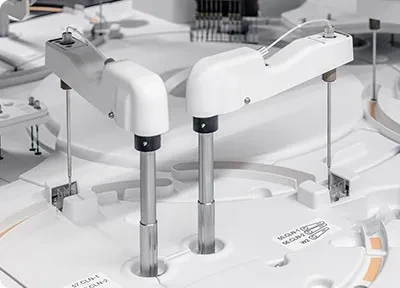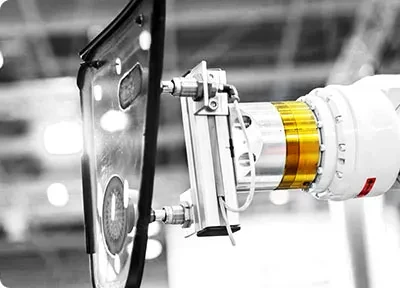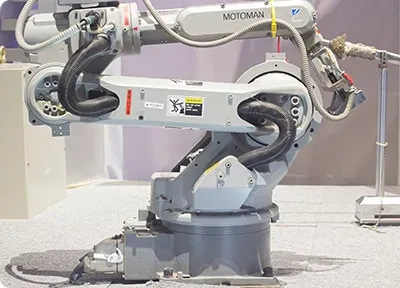Legent Laser Technology Co., Ltd.: Your Trustworthy Laser Cleaning Machine Manufacturer!
Our company was founded in 2010. It is a high-tech enterprise integrating R&D, production and sales of laser cleaning equipment, laser marking equipment, laser welding equipment, machine vision and related application control systems. Our team of optical, mechanical and software design experts develops complete laser solutions and various high-performance laser machines for marking, cleaning and welding.
Rich Product Range
We can produce laser cleaning machines, fiber laser marking machines, UV laser marking machines, CO2 laser marking machines, flying laser marking machines, dynamic focusing laser marking machines, automatic laser marking machines, large-format laser marking machines, laser welding machines, etc.
Leading Service
We have many years of industry experience and a complete production management, quality supervision, sales service operation system. Whether you want to buy a laser cleaning machine or a flying laser marking machine, just send your requirements by email and we can customize the product for you.
Wide Sales Area
Our laser equipment has been sold to more than 50 countries and regions around the world, including the United States, Germany, Italy, India, South Africa, Japan, Canada, etc.
Wide Scope of Cooperation
We have reached cooperation with more than 100 users in various industrial manufacturing fields such as aerospace, rail transportation, automobile manufacturing, precision machinery, electronics and electrical appliances, jewelry, craft gifts, etc., and finally completed more than 150 industry-specific laser application solutions.
 Laser Cleaning Solutions For Molds
Laser Cleaning Solutions For MoldsIf you ever come across a situation where the task involves the elimination of contaminants, be it from a tire mold or a build-up on a baking mold, the laser cleaning machine stands out as the most
Add to Inquiry Pulse Laser Cleaning Machine For Precision Parts
Pulse Laser Cleaning Machine For Precision PartsThe pulse laser cleaning machine stands out as an excellent option for individuals seeking a solution to effectively clean precision parts. Its gentle yet powerful cleaning capabilities make it a top
Add to Inquiry Pulse Fiber Laser Cleaning Machine For Paint Removal On Wood
Pulse Fiber Laser Cleaning Machine For Paint Removal On WoodEquipment Introduction Parameters System Characteristic ※ High-tech and non-contact cleaning No need any chemical liquid, no consumables, safe to human body and friendly to environment. ※
Add to Inquiry Laser Rust Removal Machine
Laser Rust Removal MachineLaser rust removal machine manufacturers provide you with free technical support and fast delivery worldwide. Laser rust removal machine, a high-quality rust removal equipment that is easy to
Add to Inquiry Industrial Rust Removal Cleaning Machine
Industrial Rust Removal Cleaning MachineIndustrial laser cleaning technology is a cleaning method that uses nanosecond or picosecond pulse laser to irradiate the surface of the workpiece to be cleaned. At the moment when the laser energy
Add to Inquiry Pulse Laser Cleaning Machine For Metal Surface
Pulse Laser Cleaning Machine For Metal SurfaceLaser technology has become an indispensable tool in various industries, including rust removal operations on metal surfaces. The Legent-Laser pulse laser rust removal machine is an advanced and
Add to Inquiry CW Laser Cleaning Machine
CW Laser Cleaning MachineLegent Laser supplies 1000W 1500W 20000W continuous Laser cleaning machine for removing rust and polishing surface. These equipment have the function of removing rust and polishing surface
Add to Inquiry Hand Held Laser Rust Remover
Hand Held Laser Rust RemoverIntroducing our portable laser rust remover, the ultimate solution for all your rust removal needs! With its handheld design, this laser rust removal machine is lightweight and easy to use, making it
Add to Inquiry Mold Laser Cleaning Machine
Mold Laser Cleaning MachineIf you are a professional in the mold cleaning industry, you may need a laser cleaning machine of your own to increase efficiency and productivity. Laser cleaning machines can quickly and efficiently
Add to Inquiry Shoes Mold Laser Mold Cleaning Machine
Shoes Mold Laser Mold Cleaning MachineLegent Laser's pulse laser cleaning system has significant advantages in cleaning shoe molds. Its efficient and high-precision cleaning capabilities make it ideal for removing residues from shoe mold
Add to Inquiry 1000w Laser Rust Removal Machine
1000w Laser Rust Removal MachineThe 1000-watt laser rust remover is an efficient and environmentally friendly cleaning equipment. It is suitable for cleaning various rust layers, thick layers of paint, deep oil stains, rough
Add to Inquiry Flat-top Pulse Fiber Laser Cleaning Machine
Flat-top Pulse Fiber Laser Cleaning MachineLG-PL is a flat-top light pulsed fiber laser cleaner that cleans and textures metal for complete surface treatment. Ideal for spot or small area mold cleaning.
Add to Inquiry
What is Laser Cleaning Machine
A laser cleaning machine utilizes a high-power laser beam to remove unwanted materials from surfaces. The process, known as laser ablation, involves the rapid heating of material by the focused laser light, causing it to evaporate or be blasted away by the force of the expanding vapor.
Laser Cleaning Applications
Choose the solution that suits you best.

Corvus Headquarters Complex
Cowers Commercial Cleaning Robot Landing Case:China Mobile Software Park

Electronics Industry
Cowers Commercial Cleaning Robot Landing Case:China Mobile Software Park

Industrial Cleaning
Cowers Commercial Cleaning Robot Landing Case:China Mobile Software Park

Car Repair
Cowers Commercial Cleaning Robot Landing Case:China Mobile Software Park

Building Cleaning
Cowers Commercial Cleaning Robot Landing Case:China Mobile Software Park

Aerospace
Cowers Commercial Cleaning Robot Landing Case:China Mobile Software Park

Corvus Headquarters Complex
Cowers Commercial Cleaning Robot Landing Case:China Mobile Software Park

Corvus Headquarters Complex
Cowers Commercial Cleaning Robot Landing Case:China Mobile Software Park
Features of Laser Cleaning Machine
Automated Assembly Line
The laser cleaning machine can be integrated with CNC machine tools or robots to implement remote control and cleaning, which can realize the automation of the equipment, and form a product assembly line operation and intelligent operation.
Accurate Positioning
Use optical fiber to transmit and guide the laser to make it flexible, and use the built-in scanning galvanometer to control the high-speed movement of the light spot, which is convenient for non-contacting of special-shaped parts, holes, grooves, and other parts that are difficult to reach by traditional cleaning methods. Ground laser cleaning treatment.
Good Stability
The pulse laser used in the laser cleaning machine has a long service life, usually up to 100,000 hours, with stable quality and good reliability.
No Environmental Pollution
No chemical cleaning agent is needed and no cleaning waste liquid is generated. The pollutant particles and gas generated during the laser cleaning process can be collected and purified by the portable exhaust fan to avoid environmental pollution.
Low Maintenance Cost
There is no consumption of consumables during the use of the laser cleaning machine, and the operating cost is low. In the later stage, only the lens needs to be cleaned or replaced regularly. The maintenance cost is low, and it is close to maintenance-free.
Parts of Laser Cleaning Machine




Laser Source
The laser source generates the high-intensity laser beam used for cleaning surfaces. Common types of lasers used in laser cleaning machines include fiber lasers, pulsed lasers, and continuous-wave lasers. The choice of laser source depends on factors such as the type of material being cleaned, the desired cleaning efficiency, and the specific application requirements.
Scanning System
The scanning system directs and controls the movement of the laser beam across the surface to be cleaned. It typically consists of galvanometer mirrors or mirrors mounted on high-speed motors, which deflect the laser beam in a controlled manner to scan the entire surface area. The scanning system allows for precise and uniform cleaning of the target surface.
Optical System
The optical system includes lenses, mirrors, and beam delivery optics that focus and deliver the laser beam to the surface being cleaned. The optical components help shape and control the laser beam's size, intensity, and focus spot size to optimize cleaning performance and efficiency.
Control System
The control system regulates and coordinates the operation of the laser cleaning machine, including laser power, scanning speed, beam trajectory, and other parameters. It may consist of software, controllers, and user interface components that allow operators to set and adjust cleaning parameters according to specific requirements.
Safety Features
Laser cleaning machines are equipped with safety features to protect operators and ensure safe operation. These may include interlocks, safety curtains, laser safety glasses, and warning lights to prevent accidental exposure to laser radiation and maintain a safe working environment.
Cooling System
The laser source and other components of the laser cleaning machine generate heat during operation, so a cooling system is required to dissipate heat and maintain optimal operating temperatures. The cooling system may use air or water cooling techniques to prevent overheating and ensure long-term reliability of the machine.
Fume Extraction System
Laser cleaning can produce vaporized contaminants and debris, so a fume extraction system is often integrated into the machine to remove airborne particles and gases generated during the cleaning process. The fume extraction system helps maintain air quality and prevent the accumulation of hazardous fumes in the workspace.
Motion Control System
Laser cleaning machines may include a motion control system for positioning and moving the workpiece relative to the laser beam. This allows for automated or semi-automated cleaning of large or complex surfaces, such as automotive components, aerospace parts, and machinery.
Handheld Laser Cleaning Machines
Handheld laser cleaners, also called workstations on wheels, are easy to move from one location to another.
Fiber Laser Cleaning Machines
The laser technology removes dirt and impurities on various materials, such as ceramics and metals. It uses focused laser energy to vaporize contaminants like paint, rust, and oil, which is ideal for industrial cleaning. The fiber laser cleaning system is low maintenance and can remove unwanted materials without damaging the surface texture.
Manually Loaded Cleaning Machines
Unlike handheld laser cleaning machines, these devices are 100% safe for operators. You load parts into the device before triggering the cleaning process. Depending on their chosen tool, users might perform other tasks, such as managing fixtures and opening the door. Manual workstations often come with a rotary table, helping you to meet the high throughput requirements. You can install it offline or directly into the production line.
Conveyor Laser Cleaning Machines
You install these devices directly on conveyors for surface texturing and automating impurities removal before operations. It offers advanced features to manage inconsistencies when processing large parts in areas that need cleaning. Conveyor laser cleaning system is handy in the automotive industry, where manufacturers move different parts during production.
How to Choose Laser Cleaning Machine
Power and Wavelength
The power and wavelength of the laser are crucial factors to consider when selecting a laser cleaning machine. Higher-powered lasers can remove thicker layers of contaminants, while lower-powered lasers are suitable for delicate surfaces. The appropriate wavelength depends on the type of material and contaminant being removed. Consult with the manufacturer to determine the best specifications for your specific application.
Working Area
The working area of the machine refers to the size of the surface that can be cleaned in a single pass. Choose a machine with a larger working area if you need to clean larger surfaces or if you require faster cleaning times.
Portability and Ease of Use
Laser Cleaning Machine offer the advantage of portability, making them suitable for field applications. Consider the weight and ergonomic design of the machine to ensure operator comfort and efficiency.
How to Maintain Laser Cleaning Machine
Optics Maintenance
Irregularly inspect lenses and mirrors for dirt, smudges, or damage. Use a clean, lint-free cloth or soft brush to remove debris. If there is stubborn dirt or residue, please use the appropriate cleaning solution recommended by the manufacturer. Apply the solution to a clean, lint-free cloth and gently wipe the optics, being careful not to scratch or damage them.
Laser Alignment
Follow the manufacturer’s instructions for a laser alignment check. This may involve the use of alignment targets, specialized tools, or software provided by the manufacturer. If misalignment is detected, consult the user manual or contact the manufacturer for specific alignment procedures. Adjust the laser generator according to the recommended guidelines to ensure proper alignment.
Cooling System Maintenance
Check cooling fans or radiators regularly to make sure they are clean and free of dust, debris, or blockages.Remove any dust, debris, or obstructions that may limit cooling efficiency. It is recommended to use compressed air or a soft brush to clean the heat sinks and fans.
Lubrication
Check the owner’s manual for any moving parts that need to be lubricated, such as gears, bearings, or sliders. Use the lubricant specified by the manufacturer and apply in recommended amounts and intervals. Apply lubricant to designated parts according to the manufacturer’s instructions, ensuring even distribution and avoiding over-lubrication, which can attract dirt or impede movement.
Consumables Replacement
Monitor the condition of consumable parts such as filters, protective windows, or laser cleaning nozzles. Refer to the manufacturer’s guidelines for the expected useful life of these consumables and replace them accordingly. Replace filters when clogged or damaged to maintain proper airflow and particle filtration.
Working Principle of Laser Cleaning Machine
01
High Temperature Vaporization
The highly concentrated laser beam can generate very high heat energy around the spot, so dirt can be quickly vaporized or peeled off instantly;
02
Swell and Fall Off
The scattering of the laser beam is small and the direction is stable. We can adjust the energy density of the laser by controlling the laser beam spot with different diameters, so that the dirt is heated and then changed. When the expansion force of dirt is greater than the adsorption force of dirt to the substrate, detachment and falling will occur.
03
Shock Off
The laser cleaning beam can produce a high-frequency ultrasonic wave on the solid surface, thereby causing mechanical resonance to quickly break and fall off the dirt.

How To Operate A Laser Cleaning Machine Safely
Self-Safety And Environmental Protection
Laser cleaning machines have adequate safety features on their own. High-powered machines are typically equipped with safety features such as enclosed workspaces, interlocks, and safety sensors to keep operators and bystanders safe from potential laser hazards. Compared to traditional cleaning methods such as mechanical and chemical alternatives.
Reasonable Security Measures
Laser cleaning is less of a safety risk. Most portable laser cleaning machines are small in size, low in power, and relatively safe; when using a high-power laser cleaning machine, pay attention to staying away from designated dangerous areas, and the operator should be equipped with necessary safety protection equipment, including laser protective glasses and gloves, Avoid danger.
Effective Operations Training
Learn how to use cleaning technology safely and correctly through training. In order to operate the machine safely, we will conduct related training for laser cleaning machine operations -including safety precautions, equipment operation, maintenance skills and correct fault exclusion strategies, and which settings are most suitable for your specific cleaning needs.
Applications of Laser Cleaning Machine
Industrial Cleaning
Laser cleaning machines are widely used in industrial settings for removing contaminants, such as oil, grease, dust, and scale, from metal, ceramic, and composite surfaces. They are employed in manufacturing facilities, automotive plants, aerospace industries, and metal fabrication shops to prepare surfaces for welding, painting, coating, or bonding processes.
Restoration and Conservation
Laser cleaning machines are utilized for restoring and conserving historical artifacts, monuments, and cultural heritage sites. They can safely remove layers of dirt, grime, soot, and pollutants from delicate surfaces without causing damage to the underlying material. Laser cleaning is commonly used in art restoration, museum conservation, and architectural preservation projects.
Marine and Shipbuilding
In the marine and shipbuilding industry, laser cleaning machines are used for removing rust, corrosion, and marine fouling from ship hulls, decks, propellers, and other marine structures. Laser cleaning helps to improve the efficiency of maintenance and repair operations, prolong the lifespan of marine equipment, and enhance the performance of vessels.
Aerospace and Aviation
Laser cleaning machines find applications in the aerospace and aviation industries for removing coatings, adhesives, and contaminants from aircraft components, engine parts, turbine blades, and landing gear. They are used for surface preparation, maintenance, and repair tasks to ensure the safety, reliability, and performance of aerospace equipment.
Electronics Manufacturing
In electronics manufacturing, laser cleaning machines are utilized for removing solder flux, oxides, residues, and contaminants from circuit boards, semiconductor wafers, electronic components, and precision instruments. Laser cleaning helps to improve the quality and reliability of electronic products by ensuring clean and pristine surfaces.
Medical Device Manufacturing
Laser cleaning machines are employed in the medical device manufacturing industry for cleaning and sterilizing surgical instruments, implants, medical devices, and equipment. They provide a non-contact and chemical-free cleaning method that eliminates the risk of contamination and ensures compliance with stringent quality and hygiene standards.
Nuclear Decontamination
Laser cleaning machines are used for nuclear decontamination and decommissioning projects to remove radioactive contaminants, corrosion products, and surface coatings from nuclear facilities, reactor components, and radioactive waste storage containers. Laser cleaning offers a safe and efficient method for decontaminating radioactive surfaces without generating hazardous waste or secondary pollution.
Frequently Asked Questions
We're well-known as one of the leading laser cleaning machine manufacturers and suppliers in China. If you're going to buy high quality laser cleaning machine with competitive price, welcome to get pricelist and quotation from our factory. Also, customized service is available.
Fiber Laser Handheld 50W 100W 200W 500W Laser Cleaning Machine, p laser machine, laser cleaning machine handheld




